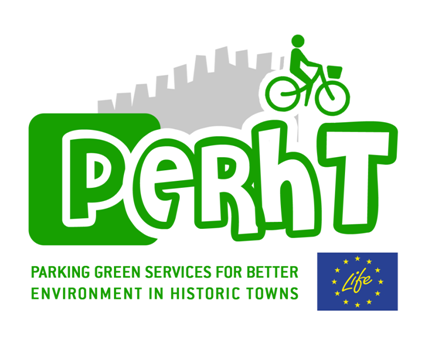
Parking green services for better environment in historic towns

The current scenario shows that: public transport is experiencing growing difficulties, which end up in decreasing attractiveness for the citizens and increasing resistance to any shift to collective services for personal mobility; parking resources and services are an indispensible component for private mobility but do have relevant impacts on urban conditions (attraction of cars in inner centre areas, traffic searching for parking, queues, pollution, etc.) which, given the small size and physical characteristics of the urban centre, are amplified and locally even more severe than in large cities; on the other hand, parking services are at the centre of urban mobility and, when operated in a clever and coordinated manner, become more and more a strategic tool for the integrated management of mobility, with relations to e.g. pedestrianised areas, Access Control Zones, Park + Ride services, etc.
THE PROJECT
The PERHT implements appropriate and innovative parking schemes and associated measures in small-/mid-size centres – particularly in historic towns, where the impacts of individual and commercial traffic are more severe. The aim is to turn parking resources and services into a key asset (infrastructural, technical, economic) for the achievement of a greener mobility.
This will be demonstrated in the historic town of Treviso, a renowned historic centre (80.000 inhabitants) located in north-east Italy, which has undertaken important actions towards a more sustainable mobility. The PERHT project will take new measures focusing on the local parking system in order to provide “green value added” individual and collective mobility services. This will significantly reduce the impacts of car traffic in the inner historical centre and improve environmental quality and energy efficiency.
The enabling core infrastructures/technologies and starting point for the project will be provided by the recently implemented parking management system, common in most small-/mid-size towns but more advanced and innovative thanks to its capability of providing vehicle detection, real-time occupancy information for each individual parking lot, dynamic booking services, etc., thus supporting the implementation of various possible parking management schemes and policies.
GOALS
The approach taken in Treviso by the PERHT project is to turn each parking facility of the local parking system (selected groups of on-street parking lots and parkhouses) into a “hub for green urban mobility” providing facilities and services that will enable achieving a number of strategic objectives, including:
- reduce the impacts of car traffic by improved management of parking services and implementation of flexible parking schemes as an instrument to support sustainable mobility policy objectives;
- provide efficient integration of parking services with public transport and other collective mobility services;
- encourage and support citizens and travellers to shift from car to a number of alternative, attractive individual and collective sustainable mobility services;
- reduce the impacts of commercial traffic (city goods distribution) by providing dedicated parking facilities (e.g. freight load/unload areas with dynamic reservation, micro-hub services, etc.) for last mile operations and better integration of city logistics in the overall urban mobility management scheme.
- promote and incentivate the take up of electric mobility for both people and goods.
The adoption of such schemes will positively contribute to reducing the adverse effects of current mobility processes and practice in people and freight transport, and will lead to relevant improvements in terms of energy saving, urban environment as well as life quality in Treviso inner historical centre. Providing a viable model with high potentials for replication in other European small-/mid-size historic towns.
RESEARCH AREA
The above objectives will be achieved through planning, implementation, demonstration and evaluation of a number of integrated urban mobility measures – regulatory, organisational, operational and technological – including:
- better integration between the parking system and public transport services and implementation of collective Park+Ride measures to enhance the capabilities of the parking system as a hub supporting the shift to sustainable mobility services;
- individual P+R measures, such as Bike Sharing services and Bike Stations (for private bikes) aiming to promote and increase cycling and multi-modal travels which use bicycles as an alternative, low cost, fast and accessible option for last mile clean mobility in the historical centre – National Priority on ;
- a new collective taxi service (Col-Taxi) in the inner historical centre with on-demand and pre-booked services, well integrated with parking and P+R facilities and providing a flexible, attractive and economic collective transport offer when regular Public Transport (i.e. fixed lines) is not available (e.g. night services, Sunday/bank holiday services, etc.);
- dedicated parking lots for freight load/unload operations in the inner historic centre together with the related information and booking services (advance booking of l/u lots, vehicle/occupancy detection, information and violation enforcement, etc.) aimed reducing the impacts of last mile freight distribution and deliveries in the historic centre; implementation of accompanying policies aimed at favouring electric and hybrid vehicles for freight delivery as well as vehicles operating with optimised load (high load factor) reducing the number of trips in the inner centre and their emissions – energy saving and emissions reduction, National Priority 2.a
- facilities (i.e. recharging stations and services) to promote and improve the use of electric vehicles in the above services and as a further complementary measure (private mobility) together with the accompanying incentive policies (e.g. free access to and circulation in the inner historical centre, priority policies for parking booking and usage, free or reduced tariff schemes, etc.) to favour electric mobility – National Priority 2.a ;
- easily accessible, pervasive ICT services for multi-modal travel information (e.g. a web portal, downloadable applications for mobile users, information kiosks/screens at key locations such as public buildings, railway station, P+R facilities, etc.) as a fundamental tool to enhance the accessibility for the citizens and travellers to integrated, dynamic information about public transport, parking (location, state, routing), bike-sharing and bike station services, on-demand collective transport services (e.g. shared taxis) and facilitate the shift to the above services and sustainable travel and urban mobility behaviours.
CONSORTIUM
A consolidated research group with a renowned academic and industrial profile.
- ACTT Spa – Azienda Consorzio Trevigiano Trasporti (IT)
- Municipality of Treviso (IT)
- MemEx Srl (IT)
- algoWatt SpA (IT)
- European Association of Historic Towns and Regions (EAHTR) (UK)
SYNOPSIS
COORDINATOR
ACTT Spa – Azienda Consorzio Trevigiano Trasporti (IT)
PROGRAM
LIFE+
START DATE
DURATION
36 months

